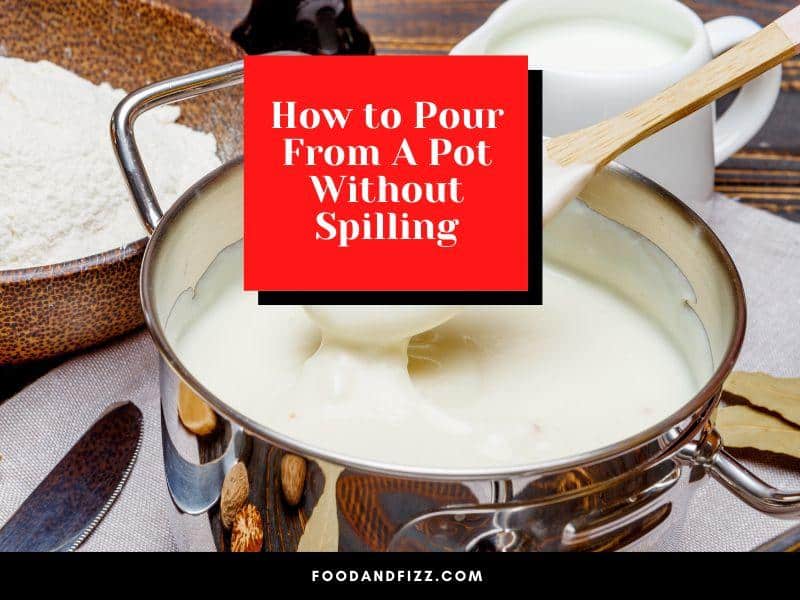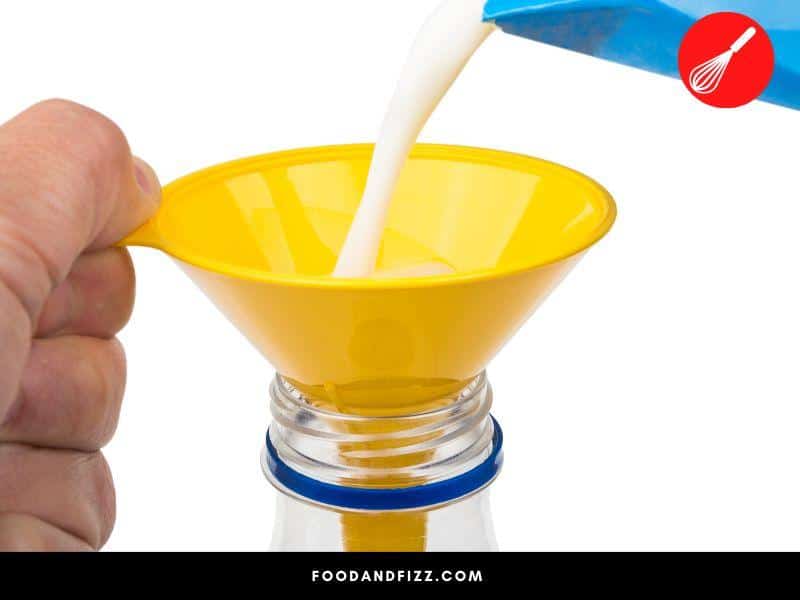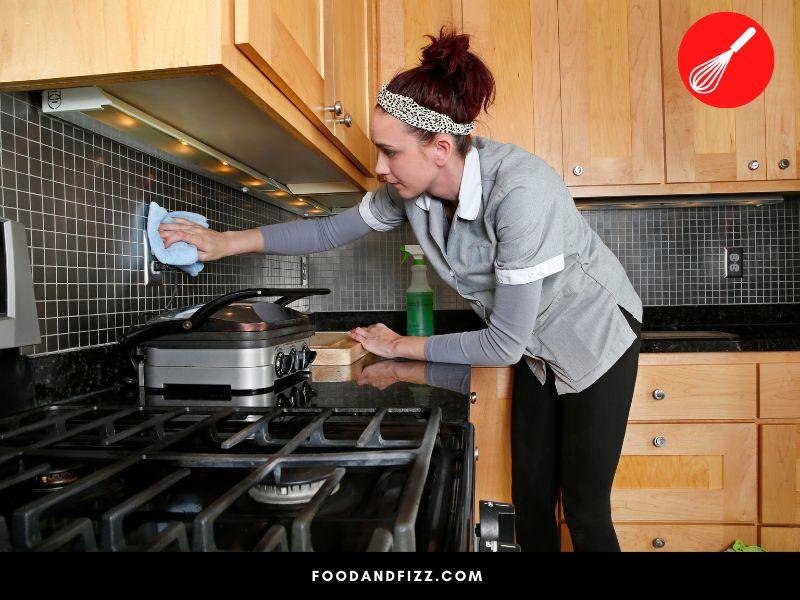In an ideal world, kitchen preparations would always be spill-free and mess-free. The reality is that it is part of life in the kitchen. That doesn’t mean, though, that there is nothing you can do to minimize it.
Pouring sauces and liquids from pots is one of these notoriously messy processes, but actually, it doesn’t have to be.
Today, we’ll look at how to pour from a pot without spilling.
How to Pour From a Pot Without Spilling
To pour liquid from a pot without spilling, a funnel can be used over the container you are pouring into, or a pot funnel or spout can be attached to the side of your pot. While pouring, it is essential to pour high and to pour fast so the liquid will not spill to the sides. A towel may also be used under the pot to catch potential spills.

How to Pour From a Pot Without Spilling
We have all been there. After laboring over that delicious sauce, we pour it over to the serving container and all of a sudden realize that a good bulk of it has spilled over onto the sides of the pot.
Even if you have a good deal of sauce left over, it’s still sad to see all that mess, and all of that sauce gone to waste.
So how do you prevent this from happening? Luckily, there’s a handy kitchen tool you can use, and a few tips you can keep in mind to avoid it happening again.
To pour from a pot without spilling, you can follow the following tips:
1. Use a Funnel Over the Bowl or Container You are Pouring Into
A funnel is a useful kitchen tool that allows you to transfer liquids seamlessly from a bigger container with a wider mouth to a smaller container without spilling. Simply place the funnel over the container you wish to transfer to and pour the liquid from your pot.
Funnels come in different sizes and especially in commercial kitchens where there is a need to transfer to different sized containers, it is very useful to have on hand.
2. Use a Pot Funnel or Pour Spout that You Can Attach to the Sides of the Pot
There is a very useful type of funnel or spout that you can use to make your pouring spill-free and mess-free.
Usually made of silicon, this contraption attaches to the sides of your pot or pan, instantly turning it into a spouted container that allows you to easily pour your liquids and sauces into a different container without spilling.
3. Choose a Pot or Container with a Spout
If you don’t have a pot funnel or spout, you can also just choose to cook with a pan or pot that has a built-in spout. Some pots are designed in this way to specifically aid with pouring.

4. Commit to the Pour
Whether you are using a funnel, a detachable spout, or a pot with a built-in one, how you pour your liquid matters. We’re often advised to proceed carefully with certain things especially while cooking in the kitchen, but pouring liquids from a pot is not one of those things where you should go slowly.
Committing to the pour is the most important thing. If you hesitate or go slowly, your sauce or liquid will in all likelihood, spill over the sides of your pan.
5. Pour High and Fast
What goes hand in hand with your commitment to pour, is to pour high and fast. According to cooks, it is important to maintain the momentum of the liquid so that it will pour out properly. Pouring from a lower height and pouring slow, especially for thicker sauces, will cause it to run down the sides of your pot. (Read about: 10 Best Ways To Thicken Yogurt Sauce).

6. Use a Towel
You can also use a towel under the pot to catch any drips before they hit the counter or the table. This tip addresses the issue of not making a mess but does not help very much with wastage as the sauce or liquid will just go to the towel, not the table, but it is still wastage.
However, it is effective in preventing any visible mess in your kitchen.
Following the above tips helps minimize any potential messes in the kitchen while you are pouring your liquids from your pots and pans.
While there are no completely foolproof methods of preventing spills, employing the tips we just outlined above will surely minimize them, and minimize potential wastage too.
What is a Funnel?
We’ve discussed using a funnel in our first tip for pouring from a pot without spilling but what exactly is a funnel?
A funnel is a tool often used in the kitchen that has a bigger opening at the top and a smaller opening on the other side. It is a tube with a wide mouth and a narrower bottom.
It is used to transfer liquid or fine ingredients from a container with a bigger opening to one that has a smaller opening, for example, transferring liquid from a pot to a bottle.
Using a funnel ensures a hassle-free and spill-free transfer, which is especially important in commercial kitchens where working space is precious and where every bit of wastage translates to actual losses.
Funnels come in different sizes and materials. We’ll explore some of them below.

Plastic Funnels
Plastic funnels are a good option for homes as they are easy to store and stack and nest, which is especially important for home kitchens that do not necessarily have the dedicated storage space of most commercial and professional kitchens.
Plastic funnels are made of hard plastic, are lighter and are easy to clean. They may not be very ideal for extremely hot liquids though, but best to check the manufacturer’s instructions.
Stainless Steel Funnels
Stainless steel funnels typically come with a handle near the top or at the sides. This feature allows them to be held in place while pouring, which is especially convenient.
Also, being made from stainless steel, it is sturdier and can withstand liquids at higher temperatures. Stainless steel also doesn’t stain or absorb any odors. This is the type typically found in professional kitchens.
Silicone Funnels
These types of funnels are typically collapsible and come in bright colors. They do the job well and are easier to store than plastic or stainless-steel funnels.
You can easily keep a bunch of them without taking up a bunch of storage space in your kitchen.
Pot Funnel or Pour Spout
Usually made of silicone, these are usually attached to the sides of the pot or pan to form a spout that makes for easy pouring. The basic one just looks like a regular, wide spout but I’ve seen some varieties where the spout design looks like a duck’s beak and actually doubles as a strainer too.
Funnels may look like they are just for lab and science experiments but they are actually pretty handy in the kitchen. They make a lot of processes easier, and especially if you keep different sizes in your kitchen, you will find more uses for them than you originally thought.
Tips For A Mess-Free Kitchen
Funnels and similar tools help a lot in preventing spills and unnecessary messes in the kitchen but we all know that cooking is inherently messy.
That is not to say that we should just let things be and accept the beautiful mess. Keeping things as clean as possible not only ensures a delightful cooking experience but ensures safety and prevents wastage as well.
Below are some useful tips to ensure a relatively mess-free kitchen.
1. Clean As You Go
In culinary school, this was one of the first things we were taught: “clean as you go”. This means that, in between cooking steps, you should put away things you won’t need anymore so you clear up some space for the other things you might need.
Cleaning as you go declutters the kitchen, and gives you more space to move and work, ensuring that your cooking experience is efficient and quick.
It also makes cleanup easier when you are done. Leaving all the cleaning to the very end will make it an even more unpleasant and overwhelming task.
2. Organize your Pots, Pans and Utensils
Keeping your utensils properly organized will make them easier to find and will make things more efficient for you in the kitchen.
If you constantly have to empty a drawer to find the vegetable peeler or you constantly have to take all the pots and pans out of the cupboard to find the right one you need, it will make for a very long and tedious cooking experience.
Granted, most of us who live in smaller places do not have the luxury of keeping everything separate and having a dedicated space for every type of pot or spatula, but at least knowing where everything is stored makes a whole lot of difference.
3. Wash Dishes Immediately
I’m kind of particular about this as I do not like leaving dirty dishes and utensils in the sink for a long time. Doing the dishes as soon as you finish cooking or very soon after eating makes things easier to clean.
When leftover food sits in pots and pans, especially for a long time, they harden and become more difficult to remove.
Worse, they may encourage bacteria and pathogens to proliferate, and these can feast on everything else in your kitchen too. Cleaning the dishes immediately helps prevent this from happening.
4. Clean Floors, Tables, and Countertops
Aside from the actual pots and pans and dishes, it is important to wipe down the tables and countertops, ovens, and stove immediately to ensure that no food bits remain on them after you’re done cooking.
Like what we said earlier about the dishes, allowing dirty tables and countertops to sit like that for a long time may cause build-up that may be harder to clean, and may encourage pests and pathogens, and bacteria to proliferate.

5. Regularly Check the Ingredients You Have in your Kitchen
If you cook a lot and spend a lot of time in your kitchen as I do, it is easy to keep track of all your ingredients, especially perishable ones, and discard them promptly once you see that they are bad. If you don’t cook a lot though, it can be more difficult to stay on top of them.
Commit to doing the rounds and checking everything once a week or once every few weeks to make sure you do not have ingredients rotting away in a cupboard somewhere that may make your kitchen an uninhabitable place for a long time.
Also, constantly check your fridge and freezer too. Doing this saves you the trouble of having to clean and sanitize your entire kitchen because you discovered something molding in a cupboard somewhere.
In the kitchen, as in life, it is always a good idea to be proactive and prevent things from happening rather than always reacting to what is thrown at us.
Kitchen spills and messes are not 100% preventable but they can be minimized through best practices in the kitchen and through tools that help us in the process.
Frequently Asked Questions to How to Pour from A Pot Without Spilling
How Do I Pour from a Large Container Without Spilling?
Using a funnel helps prevent spilling when pouring from a large container to a smaller container, especially one that has a narrow opening.
How Do I Pour From A Pan?
To pour from a pan or a pot, make sure to commit to the pour and pour fast, with a steady hand, to maintain the momentum of the liquid as it pours from your pot to the other container.
Conclusion to How to Pour From A Pot Without Spilling
Pouring from a pot without spilling can be a daunting task but kitchen tools like funnels and detachable pot spouts can make things a little bit easier.
Also, knowing how to pour properly—fast and with a steady hand– makes a huge difference and helps ensure that none of the good stuff we just made goes to waste.

